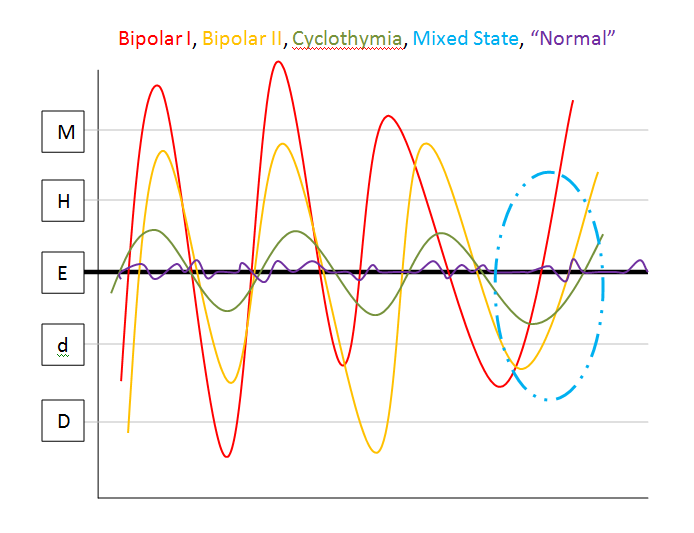Mood charts can be very useful tools to monitor your mood over time. This one was handed out by the Bipolar Psychoeducation Group.
Week 1 Handouts
The next 21 weeks
What is Bipolar?
I like analogies, so here’s the first one. I’m juggling balls. I’ve got three of them going, everything is fine, I’m smiling and chatting with the audience. As I swing up, I take on more balls. I have five, six, eight balls in the air, and look at me go, I’m amazing I can take even more, I’ve got this! How dare you suggest I am not on the verge of some amazing breakthrough where I will juggle 12 balls and swallow a sword?!
But then I start to drop them. First one goes, then another, and I’m frantically trying to catch them as they fall, and in my struggle to grab them before they hit the ground, I’m dropping the ones I had in my arms until I am collapsed on the floor, surrounded by the balls, crying over everything and nothing. I am a failure, and will never amount to anything, and what was I even thinking, trying to juggle those balls? 3 seems so far away now, such an insurmountable task.
Wash, rinse, repeat! /sigh
This is a graph of the mood swings in the bipolar spectrum, with ‘normal’ added in for clarity.
So M is Mania, H is Hypomania, E is Euthymia, d is Minor Depression, and D is Major Depression.
Euthymia is basically wellness. I couldn’t help but notice how similar it was to my favorite word, eudaimonia (loosely translated as human flourishing). The purple line I put on there to remind everyone that while “normal” people have ups and downs, they stay very close to the ‘wellness’ line.
As you can see, Bipolar I and II can both swing down into minor or major depressive episodes; the difference is that Bipolar II stops the upswing in hypomania, and doesn’t go up into an acute manic phase the way Bipolar I can. It only takes one (documented) full blown manic episode to be diagnosed BPI, even if you never swing that high again.
Mixed states (for me) are like taking the worst parts of each side and mashing them together. Imagine being really miserable and tired and unmotivated, but your mind is racing and it’s going to all the bad places at once. I get mixed rarely, and as such I handle those periods poorly.
It’s estimated that 1-2% of the population is on the bipolar spectrum. Think about it. That’s actually a lot of people, some of whom are probably wandering through life, never knowing that something can be done to alleviate the worst of the symptoms. And those who do know… well, most of them are going to hide it. That’s what we do.
If it helps, try to remember that as you age, the periods of euthymia should get longer as the swings happen less often, and the swings should become less extreme.
Lastly, this is a fantastic piece the BBC has put out there with bits from Stephen Frye to Professor Richard Morriss to Carrie Fisher. It is a worthwhile read, and as such I have saved a PDF here [ bipolar-bbc ] in case they ever take it down. I don’t trust the Wayback Machine to help me find it.
The Psychoeducation Group
I have begun a journey that is designed to last 21 weeks (with a short break for Easter). So from now until August, I will be attending a new Bipolar Psychoeducation Group here in Nottingham. Every week there are different topics to cover, and handouts and possibly even homework that I will share here, to raise awareness and share some of the experience with others.
I talked to the organizers of the group about this blog before I started it, as I felt it was important to not only get permission but to establish the ground rules that I will be abiding by. My intent is to share knowledge and as such I will be scanning in the printouts and talking about what I learned.
This group is based off of the Barcelona Protocol, named for the city where it was started, but has been adapted to better suit the UK audience (one marked difference is that this group has a ‘peer support’ person who has already been through the course and is there to help guide the group and to model the personal sharing that they’re looking for. (Fortunately they have me, and well, I am a bit blunt and tend to overshare. LOL.)
Please understand that while I may be quite open about my own experiences, I will not speak about anyone else in the group. I believe firmly in anonymity and it needs to be a safe place to discuss our lives and experiences with other people who have the same condition.
Hopefully you’ll find the documents and posts to be helpful. Bipolar doesn’t go away, but you can still have a life. The light at the end of the end of the tunnel isn’t always an oncoming train.
Psychoeducation. That’s a great word, isn’t it?
Credit where it’s due:
The Barcelona Protocol Psychoeducation Manual for Bipolar Disorder adapted for use in the NHS in England.
PARADES Psychoeducation Team
Adapted from the original:
Psychoeducation Manual for Bipolar Disorder by Francesc Colom and Eduard Vieta. Cambridge University Press, Cambridge, 2006.






